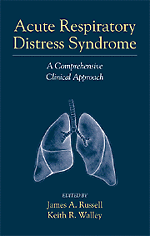Book contents
- Frontmatter
- Contributors
- Contents
- Preface
- Introduction
- 1 Overview, Clinical Evaluation, and Chest Radiology of ARDS
- 2 The Epidemiology of ARDS
- 3 The Pathology of ARDS
- 4 Cytokine -Induced Mechanisms of Acute Lung Injury Leading to ARDS
- 5 Pulmonary Pathophysiohgy in ARDS
- 6 Cardiovascular Management of ARDS
- 7 Mechanical Ventilation
- 8 Respiratory Muscles and Liberation from Mechanical Ventilation
- 9 Clinical Assessment and Total Patient Care
- 10 ARDS: Innovative Therapy
- 11 Nosocomial Pneumonia in ARDS
- 12 Resolution and Repair of Acute Lung Injury
- 13 Multiple System Organ Failure
- 14 Outcome and Long-Term Care of ARDS
- Index
11 - Nosocomial Pneumonia in ARDS
Published online by Cambridge University Press: 05 October 2010
- Frontmatter
- Contributors
- Contents
- Preface
- Introduction
- 1 Overview, Clinical Evaluation, and Chest Radiology of ARDS
- 2 The Epidemiology of ARDS
- 3 The Pathology of ARDS
- 4 Cytokine -Induced Mechanisms of Acute Lung Injury Leading to ARDS
- 5 Pulmonary Pathophysiohgy in ARDS
- 6 Cardiovascular Management of ARDS
- 7 Mechanical Ventilation
- 8 Respiratory Muscles and Liberation from Mechanical Ventilation
- 9 Clinical Assessment and Total Patient Care
- 10 ARDS: Innovative Therapy
- 11 Nosocomial Pneumonia in ARDS
- 12 Resolution and Repair of Acute Lung Injury
- 13 Multiple System Organ Failure
- 14 Outcome and Long-Term Care of ARDS
- Index
Summary
Introduction
Pneumonia is the most common infectious complication of ARDS, with published occurrence rates ranging from 15% to 70% during the period of endotracheal intubation for respiratory support. This highly variable incidence of nosocomial pneumonia in ARDS likely relates to variability in the physician's awareness of the problem, diagnostic criteria and use of antibiotics, as well as to differences in patient population and nursing and infection control standards. An important cause of intensive care morbidity, it has also become increasingly clear that pneumonia in ARDS is strongly associated with mortality. Of nosocomial infections, it has long been established that pneumonia is the leading cause of excess mortality, and in ARDS patients in particular it has been reported that patients developing pneumonia have mortality rates nearly triple that of those who do not. Although it may be that this association of nosocomial pneumonia with poor prognosis is not causal in nature, it nevertheless has led to speculation that nosocomial pneumonia is a major cause of sepsis, multiple organ system failure, and death in patients surviving acute illness precipitating ARDS. Limiting the effect of nosocomial pneumonia on outcome in ARDS requires careful attention to the principles of infection control for prevention, vigilance in diagnosis of the infection when it occurs, and appropriate antimicrobial therapy. All three of these aspects of management of pneumonia in ARDS patients involve elements of controversy. We point these out in this chapter even as we outline suggested approaches that we believe are practical without being simplistic.
- Type
- Chapter
- Information
- Acute Respiratory Distress SyndromeA Comprehensive Clinical Approach, pp. 251 - 274Publisher: Cambridge University PressPrint publication year: 1999



